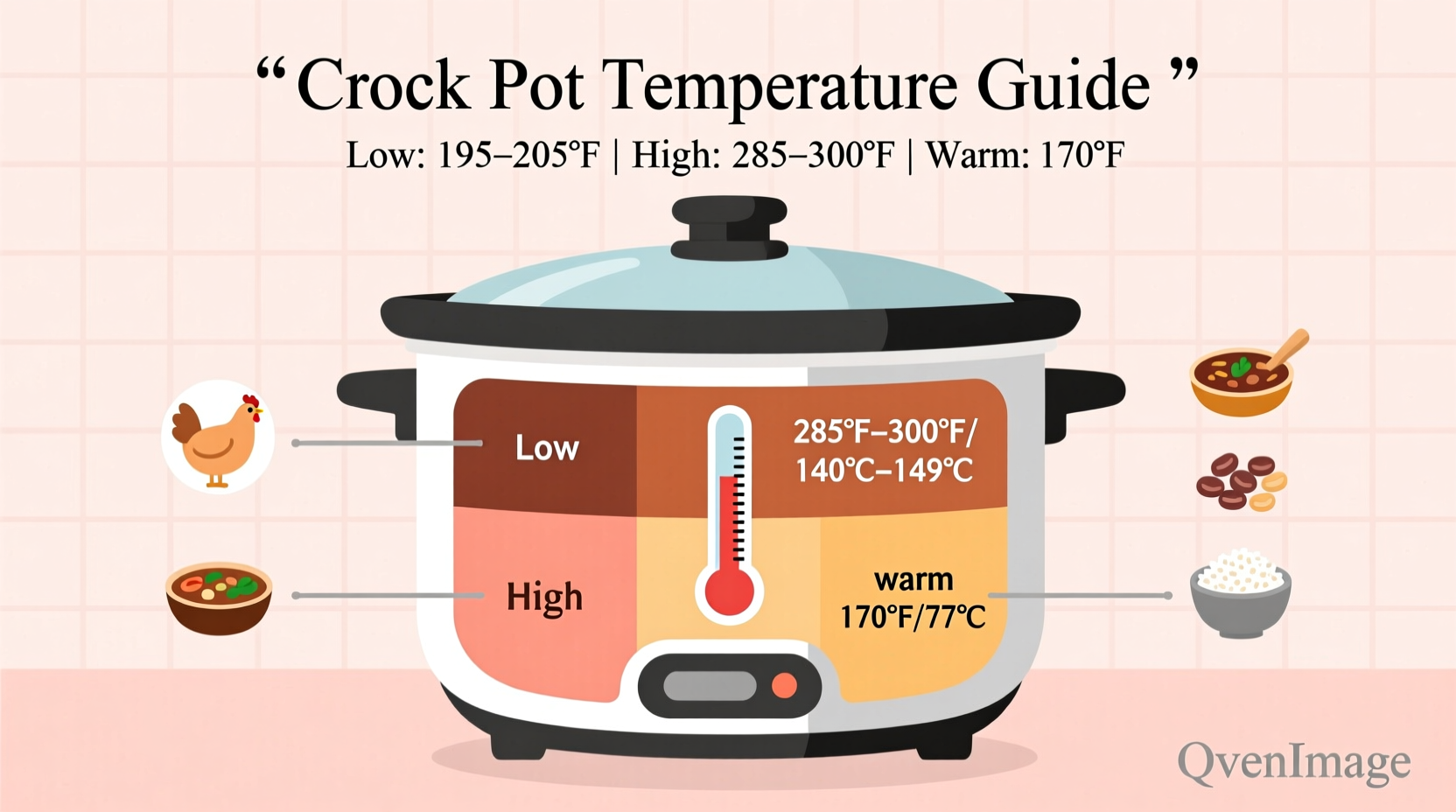Ever wondered exactly how hot your slow cooker gets during those long cooking sessions? Many home cooks operate their crock pots without understanding the precise temperatures involved, potentially compromising food safety or cooking outcomes. Let's explore the science behind slow cooker temperatures and how to use this knowledge for better results.
Understanding Crock Pot Temperature Settings
Contrary to what some believe, crock pots don't simply "simmer" at a single temperature. Each setting maintains a specific temperature range designed for different cooking needs:
| Setting | Temperature Range (°F) | Temperature Range (°C) | Best For |
|---|---|---|---|
| Low | 190-200°F | 88-93°C | 8-10 hour cooking, tougher cuts of meat, dishes requiring gentle heat |
| High | 280-300°F | 138-149°C | 4-6 hour cooking, quicker meals, dishes needing higher heat |
| Warm | 165-175°F | 74-80°C | Holding cooked food safely before serving |
This temperature chart reveals why the "low" setting isn't actually low in cooking terms—it's carefully calibrated to keep food safely above the USDA's recommended minimum internal temperature of 140°F (60°C) while allowing for tenderization over time.
The Science Behind Slow Cooking Temperatures
Slow cookers work through a combination of convection and radiant heat. The ceramic or porcelain insert absorbs heat from the surrounding heating elements, then transfers that heat to your food through direct contact and steam circulation.
According to the USDA Food Safety and Inspection Service, slow cookers are designed to cook food at temperatures that eliminate the risk of foodborne illness. The critical factor is how quickly your crock pot moves food through the "danger zone" (40°F-140°F or 4°C-60°C), where bacteria multiply rapidly.
Food Safety Timeline in Your Crock Pot
Understanding the timeline of how your crock pot reaches safe temperatures is crucial for food safety:
- 0-2 hours: The critical period when your crock pot should move food from refrigerator temperature through the danger zone
- 2-4 hours: On high setting, most crock pots reach and maintain safe cooking temperatures (above 185°F/85°C)
- 4+ hours: On low setting, crock pots typically reach optimal cooking temperatures (around 200°F/93°C)
The FDA Food Code specifies that potentially hazardous foods must pass through the danger zone within four hours. Quality slow cookers accomplish this in 2-3 hours, making them safe for unattended cooking.

Practical Temperature Applications for Home Cooks
Knowing your crock pot's actual temperatures allows you to make informed cooking decisions. Here's how different temperature settings affect specific cooking scenarios:
When Low Setting Works Best
The 200°F (93°C) low setting excels for dishes requiring long, gentle cooking:
- Tougher meat cuts like chuck roast or pork shoulder (collagen breaks down at 160°F/71°C)
- Dishes with dairy ingredients that might curdle at higher temperatures
- Recipes where you want to preserve delicate flavors
When High Setting Is Necessary
The 300°F (149°C) high setting serves specific purposes:
- Bringing liquids to a simmer more quickly
- Cooking grains like rice or quinoa that need higher temperatures to properly cook
- Situations where you need to reduce cooking time without compromising safety
Testing Your Crock Pot's Actual Temperature
Not all crock pots perform identically. To verify your appliance's actual temperature:
- Fill your crock pot ½ to ¾ full with room temperature water
- Set to desired setting (low or high)
- Insert a reliable digital thermometer
- Check temperature after 8 hours on low or 4 hours on high
According to The National Center for Home Food Preservation, a properly functioning slow cooker should maintain water temperatures above 185°F (85°C) on low setting and reach at least 200°F (93°C) within 4 hours on high setting.
Temperature Troubleshooting Guide
If your crock pot isn't reaching proper temperatures:
- Problem: Takes too long to heat up Solution: Start with warm ingredients rather than cold
- Problem: Doesn't maintain consistent temperature Solution: Check for damaged heating elements or thermostat
- Problem: Food not cooking properly despite long cooking times Solution: Verify actual temperature with thermometer; consider appliance age
Advanced Temperature Control Techniques
Professional chefs use these temperature management strategies with slow cookers:
- The two-phase method: Start on high for 1-2 hours to quickly move through the danger zone, then switch to low for remaining cooking time
- Lid management: Limit opening the lid to prevent 10-15°F (5-8°C) temperature drops each time
- Thermometer monitoring: Use a leave-in probe thermometer for critical dishes like poultry
- Recipe conversion: When adapting conventional recipes, reduce liquid by 25% and increase cooking time significantly
Special Considerations for Different Foods
Certain foods require specific temperature considerations in slow cookers:
- Poultry: Must reach 165°F (74°C) internal temperature—use a thermometer to verify
- Dairy: Add cream or milk in the last hour to prevent curdling at sustained high temperatures
- Beans: Always pre-boil dried beans for 10 minutes before slow cooking to destroy toxins
- Thickening: Use cornstarch slurry in the last 30 minutes as prolonged high heat breaks down thickening agents











 浙公网安备
33010002000092号
浙公网安备
33010002000092号 浙B2-20120091-4
浙B2-20120091-4